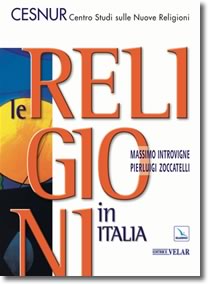 Massimo Introvigne - PierLuigi Zoccatelli (sotto la direzione di), Le religioni in Italia, Elledici - Velar, Leumann (Torino) - Gorle (Bergamo) 2006, pp. 1.152, euro 75,00
Massimo Introvigne - PierLuigi Zoccatelli (sotto la direzione di), Le religioni in Italia, Elledici - Velar, Leumann (Torino) - Gorle (Bergamo) 2006, pp. 1.152, euro 75,00
CESNUR’s main project, since its foundation in 1988, was the publication of a reliable statistical, historical, and descriptive map of religions in Italy. This project, for years in the making, is now complete. The 1,152-page encyclopedia Le religioni in Italia (“Religions in Italy”) includes entries (with information on history and doctrine, short bibliography, address, telephone, E-mail and URL) on more than 600 religious and spiritual groups active in Italy, with large general introductions to each family or subfamily of movements or denominations.
See for a list of entries (and a map of religious and spiritual groups active in Italy) the Encyclopedia’s Table of Contents.
Please note: As the "Introduction" chapter of the Encyclopedia explains, the definition or description of "religion and spirituality" used for the text is large and inclusive. We do not believe that this description is more "true" or valid than others; in fact, all definitions of religion are result-oriented, and ours is oriented to the cognitive result of providing as much information as possible on the Italian spiritual scene. Although we do include information on groups not regarding themselves as religious (from several branches of the Radhasoami tradition to the Theosophical Society, Transcendental Meditation, or New Acropolis), we do respect their self-perception and agree that, according to other definitions, they should and would not be regarded as "religious". In fact, the "Introduction" states that "arguing from the mere inclusion in this Encyclopedia that a group should be regarded as religious in other contexts, e.g. in a legal context, would not make sense (either when it is claimed that groups regarding themselves as non-religious are in fact religious, or vice versa)". The different branches of Italian Freemasonry and the "religiously irreligious" organizations of atheists or secular humanists are a special case; we do not regard them as "religious", not even in the broader sense, and we discuss their relationship with religion not in the text but in a separate Appendix. Ultimately, we do not presume to settle in the Encyclopedia the question of the "true" nature of several groups. More modestly, we offer entries on groups the average person reading an "Encyclopedia of Religions" would likely be interested in (if only in order to conclude, having read the entry, that a particular group is in fact not "religious", according to the reader’s own definition).

